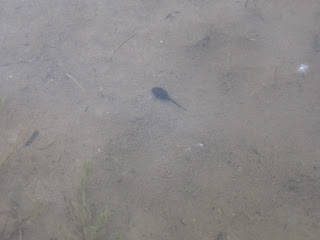
Sewer grate c1959. Located near the mouth of Taylor-Massey Creek and demarcates the merging of 3 sewer mains into the Coxwell Sanitary Sewer. Warning: the odour from this access tunnel is very strong and shouldn't be approached by those with a weak stomach!
After a flurry of fairly high profile news items earlier this year, the story of the Coxwell sanitary sewer problems has fallen off the radar. This does not mean that work has slowed down. Far from it. Toronto Water has been very busy with a wide range of activities from setting up monitoring devices to developing contingency plans in the event of a failure of the sewer to plans that will lead to eventual repair of the sewer.
There are two foreseeable outcomes. The first is that the sewer fails in the near future which would have dire consequences for the Don River. The second (and much more likely) course of events is that Toronto Water successfully completes repairs on the sewer main and everything works out OK.
Let me start with the bad news scenario. Since the damage to the sewer was discovered, the city has taken steps to make plans in the event of a failure. No one knows when the damage to the sewer occurred or how extensive the damage is. Nor are they sure how long the sewer will last. It could fail today or it could last another 60 years. Given this situation city staff have to plan for the worst. In the event of a failure the plan is to divert the sewage into the Don River. The flow in the pipe is about 6 m3/s or about 4 times the normal flow of the Don River. The effluent would flow all the way down the river to the harbour. The plan calls for the effluent to be treated in the Keating Channel which would remove the worst of the flow but the remaining water would be highly polluted.
The effect of this would be catastrophic. All oxygen would be removed from the river and everything now living in the river would die. Water in the harbour would be highly anaerobic and E. coli levels would be through the ceiling. The combined sewer and river flow would be contained in the river channel but a rainstorm during this flow would likely cause the river to overflow the banks causing sewage laden waters to flood the lower Don Valley. No matter how you look at it, a collapse would be a major environmental disaster.
In the meantime work is underway to build a bypass around the damaged pipe. Two options are being evaluated, a temporary bypass and a permanent bypass. The temporary bypass would involve constructing one or more pipes above ground. The pipes would extend from the bottom of the valley near the mouth of Taylor-Massey Creek up to the corner of Coxwell and O'Connor. A shaft would be dug at that corner back down to the pipe. The sewer contents would be pumped up the side of the valley and back down the shaft to reenter the pipe downstream from the damaged section.
The permanent bypass solution would tunnel underground roughly parallel to the existing pipe and create a diversion around the damaged section. Either solution would allow engineers to enter the existing pipe to initiate repairs. The timeline for both options is 9-12 months and would cost about $30 million. The temporary would take a little less time but would be more damaging to the natural landscape of the valley. Also the temporary solution allows for only one oppotunity for repairs. Since the cost for both options is roughly similar and the timelines are not that far apart, city staff are leaning towards the permanent solution.
It is good to know that the city is taking the situation very seriously and I am confident that the plans in place are sufficient to produce a positive outcome. I rate the possibility of failure of the sewer to be very low. I am reasonably certain that by the end of this project we will again have a working sewer and the Don River will continue to flow without the added complication of input from the Coxwell sewer.
For anyone who wants additional information on this subject, you can view Toronto Water's slideshow presentation to the Public Works Committee from January 2009.



























